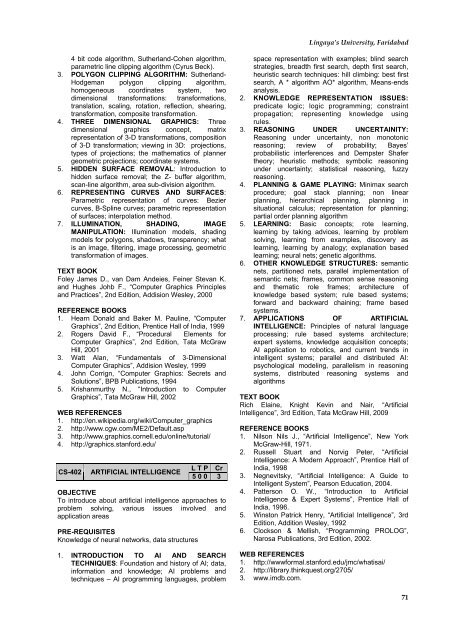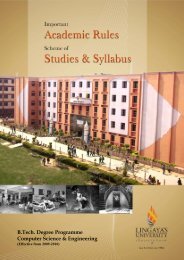B.<strong>Tech</strong>. <strong>Electrical</strong> <strong>Engineering</strong> (Regular)REFERENCE BOOKS1. Rangwala S. C. and Krishnarjun N., “TownPlanning”, Charotar Publishing House, Anand,1985.2. Pramar V. S., “Design Fundamentals inArchitecture”, Somaiya Publications, New Delhi.WEB REFERENCES1. www.jadavpur.edu/academics/.../Architecture/archsyl.htm2. www.oauife.edu.ng/faculties/edm/arch/coursedescription.pdf3. www.unitytempleutrf.org/Unity%20Temple%20Teaches.pdfissuu.com/brentallpress/docs/adr3_vol3_1CH-471ADVANCED APPLIED L T P CrCHEMISTRY 5 0 0 3OBJECTIVETo make students familiar with the concept of chemistryassociated with dairy life, with the general method ofanalysis and other aspects related to engineering field.1. FUELS & PETROCHEMICALS TECHNOLOGY:Classification of fuels; coal biomass; biogasdetermination of calorific values using bombcalorimeter; bio- fuels and liquid fuels; generalconsideration of petrochemicals; an overview ofpetroleum refining; petroleum transpiration; anelementary ideas of petrochemicals; petroleumrefining -catalytic cracking & naptha reforming.2. CHEMICALS TOXICOLOGY: Introduction; kind oftoxic pollutants; toxic chemicals in air water andsoil; toxic elements in waste water; carcinogenesis,impact of toxic chemicals on enzymes; biochemicaleffects of As ,Cd, Pg, Hg, CO, NO 2 , O 3 CN- Toxicmetal pollutants; Toxic minerals and dust; Toxicorganic compounds .3. ENVIRONMENTAL HAZARDS & POLLUTION:Cause; Effects; control & measures of waterpollution; soil pollution; thermal pollution; Nuclearpollution; solid waste management; industrialwaste and bio-medical waste management; cause;effects and control measures of urban andindustrial waste.4. INDUSTRIAL WASTE MANAGEMENT:Magnitude of industrial waste generation & theircharacteristics; effluent standards for disposal intowater bodies; waste water characterization &process survey; advanced treatment &sludgehanding; combined treatment of raw industrialwaste with sewage; common effluent treatment forindustrial estates; management of industrial wastefrom small scale industries; Selection procedure forphysical, chemical & biochemical methods ofindustrial waste water treatment.5. CORROSION & ITS CONTROL: Introduction; drycorrosion; wet corrosion; mechanism of wetcorrosion galvanic corrosion; concentration; Cell;corrosion fitting corrosion; inergranular corrosion;waterline corrosion; stress corrosion; galvanicseries; factors influencing corrosion; controlmethods.6. POLYMER TECHNOLOGY: Introduction of naturaland synthetic polymers; classification of polymerson different basis; Natural rubber; Source;Formula; Elasticity of rubber; chemical relativity;properties; isomerism in rubber; vulcanized rubberand its uses .7. ADVANCED ANALYTICAL METHODS: Thermoanalytical methods; Thermo gravimetric analysis(TGA); Differential thermal analysis (DTA);Differential scanning calorimetry (DSC);Instrumentation; Flame photometry;spectrophotometry; conductometry; conductometrychromatographic methods; Adsorption; liquid -liquid partition; ion-exchange; paper & thin-layerchromatography; gas chromatography; HPLC &Electrophorisis.TEXT BOOKJain & Jain, “<strong>Engineering</strong> Chemistry”, Dhanpat RaiPublishing Co.REFERENCE BOOKS1. Drago, “Physical Methods of Chemistry”, 2ndEdition, Saunders College Publishing, 1977.2. Hutzinger, “Hand Book of EnvironmentalChemistry”, Springer Verlag3. Fristschen L. J. and Gay L. W., “EnvironmentalInstrumentation”, Springer Verlag4. Bhatia H. S., “Environmental Pollution andControl”, Galgotia Publications, 20035. Khopkar S. M., “Basic Concept of AnalyticalChemistry”, 2nd edition, New Age Publications,1998CS-303COMPUTER GRAPHICSL T P Cr5 0 0 3OBJECTIVEStudents completing this course are expected to beable to:• Write programs that utilize the OpenGL graphicsenvironment.• Use polygonal and other modeling methods todescribe scenes.• Understand and be able to apply geometrictransformations.• Create basic animations.• Understand scan-line, ray-tracing, and radiosityrendering methodsPRE-REQUISITESKnowledge of computer programming, 2D and 3Dgeometry1. INTRODUCTION: What is computer graphics,computer graphics applications, computergraphics hardware and software, twodimensional graphics primitives: points andlines, line drawing algorithms: DDA,Bresenham’s; circle drawing algorithms: usingpolar coordinates, Bresenham’s circle drawing,mid point circle drawing algorithm; polygon fillingalgorithm, boundary filled algorithm, scan-linealgorithm, flood fill algorithm.2. TWO DIMENSIONAL VIEWING: The 2-D viewingpipeline, windows, viewports, window to view portmapping; clipping: point, clipping line (algorithms):70
Lingaya’s University, Faridabad4 bit code algorithm, Sutherland-Cohen algorithm,parametric line clipping algorithm (Cyrus Beck).3. POLYGON CLIPPING ALGORITHM: Sutherland-Hodgeman polygon clipping algorithm,homogeneous coordinates system, twodimensional transformations: transformations,translation, scaling, rotation, reflection, shearing,transformation, composite transformation.4. THREE DIMENSIONAL GRAPHICS: Threedimensional graphics concept, matrixrepresentation of 3-D transformations, compositionof 3-D transformation; viewing in 3D: projections,types of projections; the mathematics of plannergeometric projections; coordinate systems.5. HIDDEN SURFACE REMOVAL: Introduction tohidden surface removal; the Z- buffer algorithm,scan-line algorithm, area sub-division algorithm.6. REPRESENTING CURVES AND SURFACES:Parametric representation of curves: Beziercurves, B-Spline curves; parametric representationof surfaces; interpolation method.7. ILLUMINATION, SHADING, IMAGEMANIPULATION: Illumination models, shadingmodels for polygons, shadows, transparency; whatis an image, filtering, image processing, geometrictransformation of images.TEXT BOOKFoley James D., van Dam Andeies, Feiner Stevan K.and Hughes Johb F., “Computer Graphics Principlesand Practices”, 2nd Edition, Addision Wesley, 2000REFERENCE BOOKS1. Hearn Donald and Baker M. Pauline, “ComputerGraphics”, 2nd Edition, Prentice Hall of India, 19992. Rogers David F., “Procedural Elements forComputer Graphics”, 2nd Edition, Tata McGrawHill, 20013. Watt Alan, “Fundamentals of 3-DimensionalComputer Graphics”, Addision Wesley, 19994. John Corrign, “Computer Graphics: Secrets andSolutions”, BPB Publications, 19945. Krishanmurthy N., “Introduction to ComputerGraphics”, Tata McGraw Hill, 2002WEB REFERENCES1. http://en.wikipedia.org/wiki/Computer_graphics2. http://www.cgw.com/ME2/Default.asp3. http://www.graphics.cornell.edu/online/tutorial/4. http://graphics.stanford.edu/CS-402ARTIFICIAL INTELLIGENCEL T P Cr5 0 0 3OBJECTIVETo introduce about artificial intelligence approaches toproblem solving, various issues involved andapplication areasPRE-REQUISITESKnowledge of neural networks, data structures1. INTRODUCTION TO AI AND SEARCHTECHNIQUES: Foundation and history of AI; data,information and knowledge; AI problems andtechniques – AI programming languages, problemspace representation with examples; blind searchstrategies, breadth first search, depth first search,heuristic search techniques: hill climbing: best firstsearch, A * algorithm AO* algorithm, Means-endsanalysis.2. KNOWLEDGE REPRESENTATION ISSUES:predicate logic; logic programming; constraintpropagation; representing knowledge usingrules.3. REASONING UNDER UNCERTAINITY:Reasoning under uncertainty, non monotonicreasoning; review of probability; Bayes’probabilistic interferences and Dempster Shafertheory; heuristic methods; symbolic reasoningunder uncertainty; statistical reasoning, fuzzyreasoning.4. PLANNING & GAME PLAYING: Minimax searchprocedure; goal stack planning; non linearplanning, hierarchical planning, planning insituational calculus; representation for planning;partial order planning algorithm5. LEARNING: Basic concepts; rote learning,learning by taking advices, learning by problemsolving, learning from examples, discovery aslearning, learning by analogy; explanation basedlearning; neural nets; genetic algorithms.6. OTHER KNOWLEDGE STRUCTURES: semanticnets, partitioned nets, parallel implementation ofsemantic nets; frames, common sense reasoningand thematic role frames; architecture ofknowledge based system; rule based systems;forward and backward chaining; frame basedsystems.7. APPLICATIONS OF ARTIFICIALINTELLIGENCE: Principles of natural languageprocessing; rule based systems architecture;expert systems, knowledge acquisition concepts;AI application to robotics, and current trends inintelligent systems; parallel and distributed AI:psychological modeling, parallelism in reasoningsystems, distributed reasoning systems andalgorithmsTEXT BOOKRich Elaine, Knight Kevin and Nair, “ArtificialIntelligence”, 3rd Edition, Tata McGraw Hill, 2009REFERENCE BOOKS1. Nilson Nils J., “Artificial Intelligence”, New YorkMcGraw-Hill, 1971.2. Russell Stuart and Norvig Peter, “ArtificialIntelligence: A Modern Approach”, Prentice Hall ofIndia, 19983. Negnevitsky, “Artificial Intelligence: A Guide toIntelligent System”, Pearson Education, 2004.4. Patterson O. W., “Introduction to ArtificialIntelligence & Expert Systems”, Prentice Hall ofIndia, 1996.5. Winston Patrick Henry, “Artificial Intelligence”, 3rdEdition, Addition Wesley, 19926. Clockson & Mellish, “Programming PROLOG”,Narosa Publications, 3rd Edition, 2002.WEB REFERENCES1. http://wwwformal.stanford.edu/jmc/whatisai/2. http://library.thinkquest.org/2705/3. www.imdb.com.71
- Page 1 and 2:
B.Tech. Degree ProgrammeElectrical
- Page 5 and 6:
Lingaya’s University, FaridabadAB
- Page 7 and 8:
IMPORTANT ACADEMIC RULESB.Tech. Deg
- Page 9 and 10:
Lingaya’s University, Faridabadac
- Page 11 and 12:
Lingaya’s University, FaridabadSe
- Page 13 and 14:
Lingaya’s University, FaridabadIn
- Page 15 and 16:
CATEGORY-WISE LIST OF COURSESLingay
- Page 17 and 18:
Lingaya’s University, FaridabadSU
- Page 19 and 20:
Lingaya’s University, FaridabadSc
- Page 22 and 23:
B.Tech. Electrical Engineering (Reg
- Page 24 and 25: B.Tech. Electrical Engineering (Reg
- Page 26 and 27: B.Tech. Electrical Engineering (Reg
- Page 28 and 29: B.Tech. Electrical Engineering (Reg
- Page 30 and 31: B.Tech. Electrical Engineering (Reg
- Page 32 and 33: B.Tech. Electrical Engineering (Reg
- Page 34 and 35: B.Tech. Electrical Engineering (Reg
- Page 36 and 37: B.Tech. Electrical Engineering (Reg
- Page 38 and 39: B.Tech. Electrical Engineering (Reg
- Page 40 and 41: B.Tech. Electrical Engineering (Reg
- Page 42 and 43: B.Tech. Electrical Engineering (Reg
- Page 44 and 45: B.Tech. Electrical Engineering (Reg
- Page 46 and 47: B.Tech. Electrical Engineering (Reg
- Page 48 and 49: B.Tech. Electrical Engineering (Reg
- Page 50 and 51: B.Tech. Electrical Engineering (Reg
- Page 52 and 53: B.Tech. Electrical Engineering (Reg
- Page 54 and 55: B.Tech. Electrical Engineering (Reg
- Page 56 and 57: B.Tech. Electrical Engineering (Reg
- Page 58 and 59: B.Tech. Electrical Engineering (Reg
- Page 60 and 61: B.Tech. Electrical Engineering (Reg
- Page 62 and 63: B.Tech. Electrical Engineering (Reg
- Page 64 and 65: B.Tech. Electrical Engineering (Reg
- Page 66 and 67: B.Tech. Electrical Engineering (Reg
- Page 68 and 69: B.Tech. Electrical Engineering (Reg
- Page 71 and 72: OPEN ELECTIVELingaya’s University
- Page 73: Lingaya’s University, Faridabadch
- Page 77 and 78: Lingaya’s University, Faridabad6.
- Page 79 and 80: Lingaya’s University, FaridabadEL
- Page 81 and 82: Lingaya’s University, Faridabad5
- Page 83 and 84: Lingaya’s University, Faridabador
- Page 85 and 86: Lingaya’s University, Faridabad4.
- Page 87: Lingaya’s University, Faridabad83
















